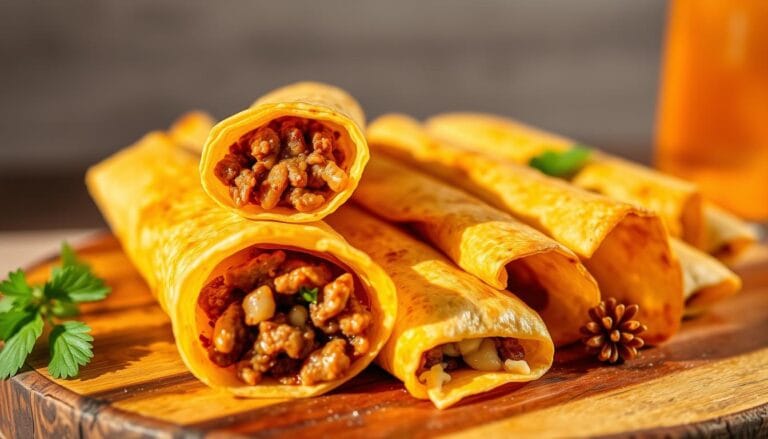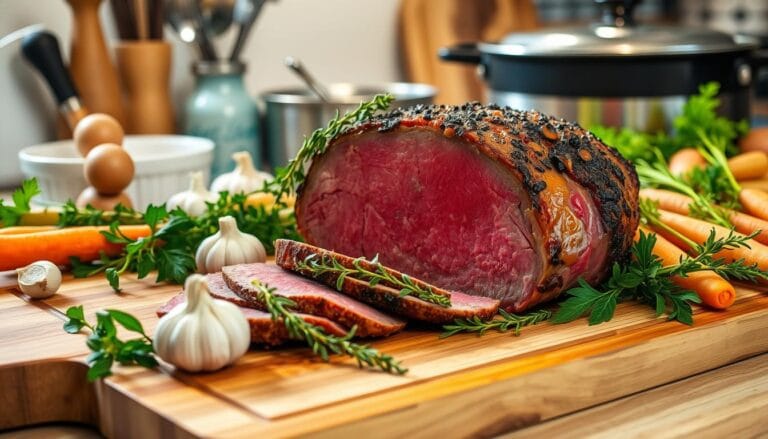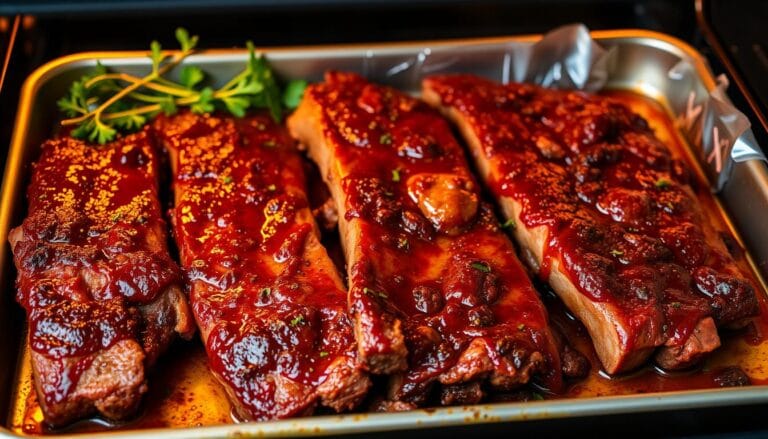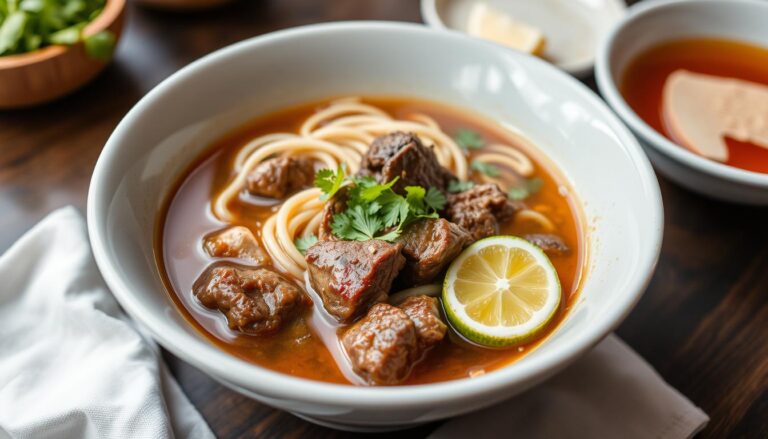Flavorful Teriyaki Beef Jerky: A Must-Try Recipe
Ever wanted something salty and sweet but store-bought snacks didn’t cut it? This teriyaki beef jerky recipe is a game-changer. Imagine biting into meat strips covered in a sweet soy, garlic, and spicy glaze. It’s all made in your kitchen, so you know exactly what you’re getting.
This recipe for teriyaki beef jerky turns regular beef into a tasty, protein-rich snack. It’s perfect for backpacking, road trips, or just enjoying at home.
Table of Contents
Key Takeaways
- Create a balanced blend of sweet and umami flavors at home.
- Cut costs and avoid additives with this easy teriyaki beef jerky recipe.
- Choose the best cuts of beef for tender, never rubbery results.
- Master two drying methods for perfectly chewy jerky.
- Customize your recipe for teriyaki beef jerky with optional heat or smoky notes.
The Appeal of Homemade Teriyaki Beef Jerky
Making your own teriyaki beef jerky recipe has many benefits. You control every step, from picking ingredients to adjusting flavors. It’s a tradition worth adding to your kitchen.
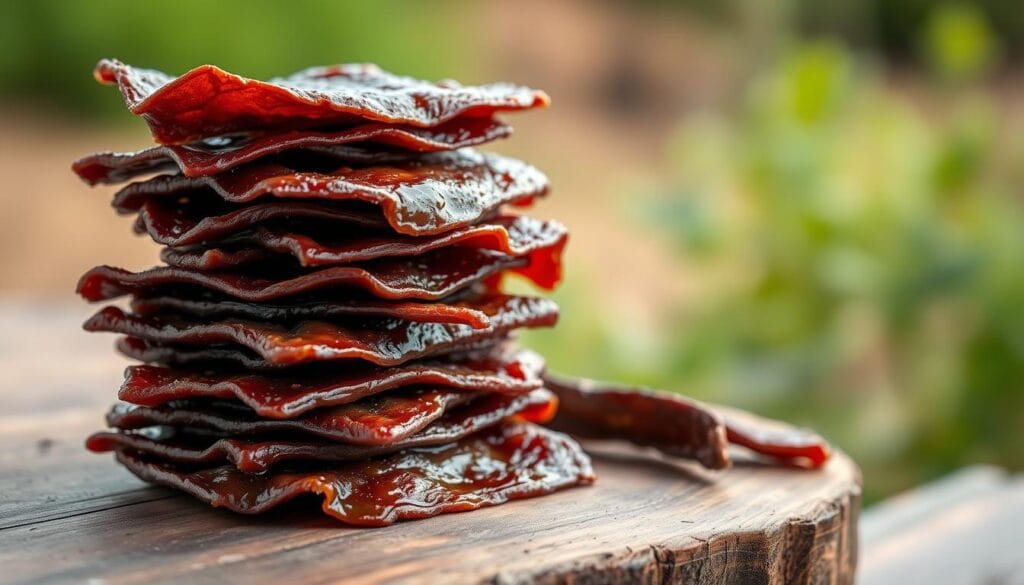
Nutritional Benefits of Beef Jerky
With a homemade teriyaki jerky recipe, you can choose healthier ingredients. Use lean cuts like eye of round for high protein content. You can also cut down on sodium and avoid artificial preservatives.
Adjust the sugar level with honey or maple syrup. This makes your jerky even healthier.
Cost Savings Over Store-Bought Options
| Option | Cost per Ounce | Ingredients Quality |
|---|---|---|
| Store-Bought (Krave) | $1.25 | Contains nitrates |
| Homemade | $0.50 | No artificial additives |
Control Over Ingredients and Flavors
- Adjust sweetness with brown sugar or molasses
- Remove soy sauce to make gluten-free versions
- Enhance umami with tamari or miso in your teriyaki jerky recipe
Try adding smoky paprika or garlic powder for new tastes. Unlike big brands, you choose what goes into your jerky.
Essential Equipment for Making Beef Jerky at Home
Creating homemade teriyaki beef jerky marinade starts with the right tools. Let’s break down what you need to turn raw meat into savory snacks.
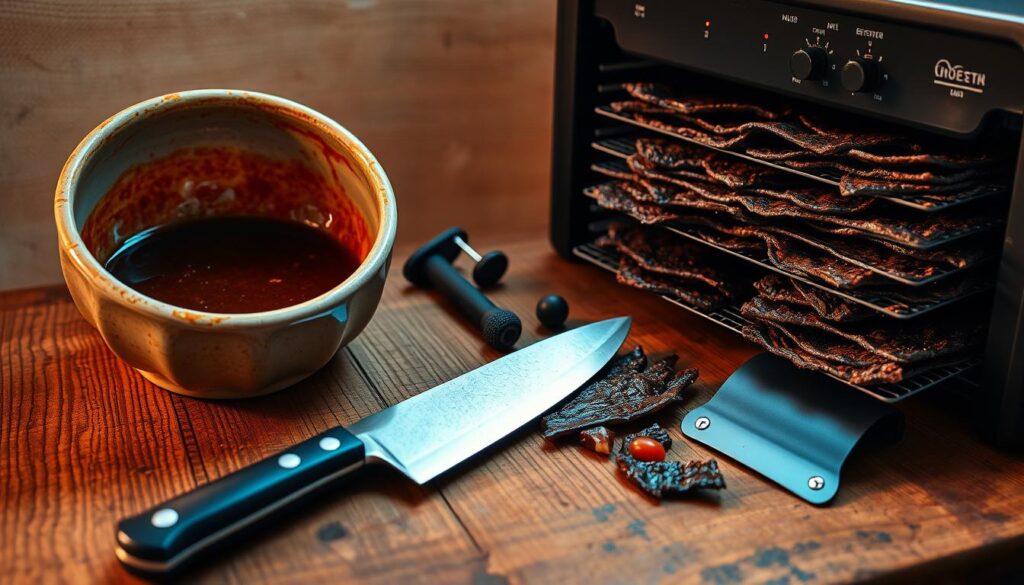
- Sharp knife or meat slicer: Cuts meat uniformly for even drying.
- Food-grade mixing bowls: Mix teriyaki jerky marinade ingredients thoroughly.
- Meat tenderizer: Breaks muscle fibers to boost marinade absorption.
- Airflow racks: Elevate meat during drying to ensure even airflow.
For drying, choose between:
| Equipment | Dehydrator | Oven |
|---|---|---|
| Temperature Control | 165°F preset | Requires door propping for airflow |
| Time | 4-6 hours | 4-6 hours with racks |
| Cost | $50–$200 investment | Use existing appliance |
Storage tools like vacuum sealers preserve freshness. Marinade injectors ensure deeper flavor penetration. Even a simple cookie sheet works for small batches. Start with what you have—upgrade as your skills grow!
Best Cuts of Beef for Making Teriyaki Beef Jerky
Choosing the right beef cut is key for tender and tasty teriyaki beef jerky recipe. Lean cuts are best because they don’t get greasy when dried. Here are the top picks for your next batch.
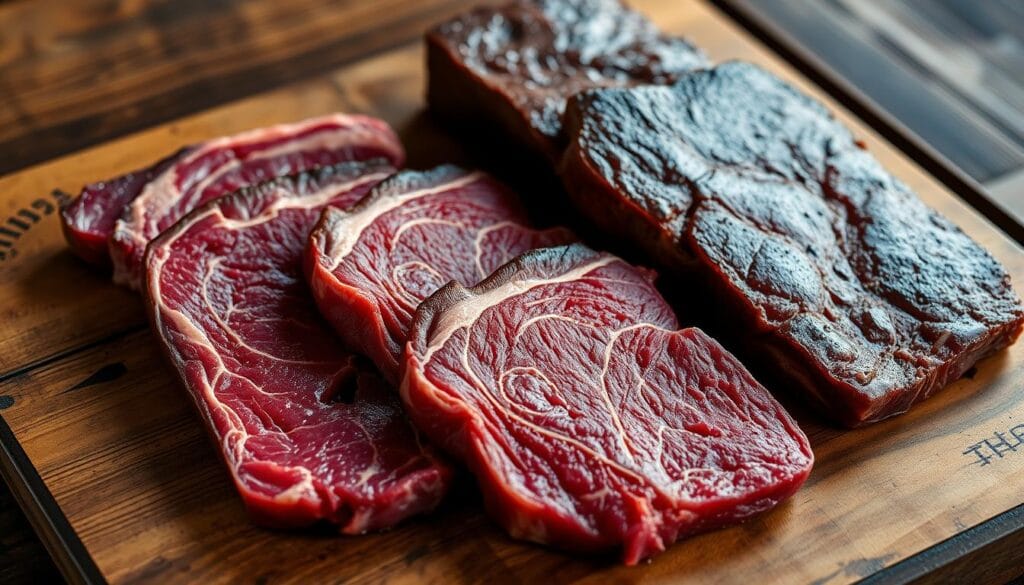
These cuts offer a good mix of cost, texture, and flavor absorption. Let’s see how each option compares:
Eye of Round
It’s the leanest cut with little fat. Its uniform shape makes slicing easy. Find it near the hind leg. Slice against the grain for a chewy texture. It costs $6–$8/lb and keeps well.
Top Round
It’s a great choice for flavor and cost. Slightly fattier than eye of round, it’s perfect for home cooks. Found in the leg, it costs $5–$7/lb. Slice against the grain for the best taste.
Bottom Round
It’s budget-friendly at $4–$6/lb. Less tender than top picks but still works. Look for it near the lower leg. Slice with the grain to soften it.
Sirloin Tip
It has more fat for flavor but has a shorter shelf life. It pairs well with bold teriyaki beef jerky marinade flavors. Slice against the grain. Costs $5–$7/lb and comes from the sirloin.
Check for visible marbling—too much fat means uneven drying. Try these cuts to find your favorite in this teriyaki beef jerky recipe. Start with eye of round for consistent results!
The Perfect Teriyaki Beef Jerky Recipe
Ready to make your own teriyaki jerky? This recipe for teriyaki beef jerky combines tradition and your own touch. It makes sure every piece is full of flavor. Follow these steps to make a snack that beats the ones you buy.
Ingredient List
| Ingredients | Quantity |
|---|---|
| Beef (eye of round, top round, or sirloin tip) | 2–3 lbs |
| Soy sauce | 1/2 cup (substitute coconut aminos for soy-free) |
| Brown sugar | 1/3 cup |
| Mirin | 1/4 cup |
| Rice vinegar | 3 tbsp |
| Minced ginger | 1 tbsp |
| Garlic powder | 1 tsp |
| Sesame oil | 2 tbsp |
Preparation Time and Yield
- Cut beef into ¼-inch strips: 20 minutes
- Marinate for 12–24 hours (refrigerated)
- Drying time: 4–8 hours (oven/dehydrator)
Yield: 1 lb dried jerky from 3 lbs raw beef. It costs $8–12 per batch, making 8–10 servings. You can adjust the marinade to your liking. Add red pepper flakes for spice or pineapple juice for a tangy twist.
Creating the Ultimate Teriyaki Jerky Marinade
Starting with your teriyaki beef jerky marinade means knowing its origins. Traditional Japanese teriyaki mixes soy sauce, mirin, and sake. Today, we add flavors from around the world. This guide will help you make a marinade that suits your taste.
Traditional vs. Modern Teriyaki Flavors
- Traditional: Classic Japanese blends use soy sauce, mirin, and sake for umami depth.
- Modern: Add ginger, garlic, or pineapple for tropical flair, or Korean gochujang for heat.
Balance Sweet and Savory
| Component | Sweet Elements | Savory Elements | Tip |
|---|---|---|---|
| Ratios | Honey, brown sugar | Soy sauce, liquid smoke | Use 1 part sweet to 3 parts savory to prevent stickiness. |
| Texture | Apple cider vinegar cuts sweetness | Worcestershire sauce adds depth | Marinate for 8-12 hours for even absorption. |
Marinade Variations
Try these changes on your teriyaki jerky marinade:
- Spicy: Stir in sriracha or red pepper flakes.
- Hawaiian: Add pineapple juice for tanginess.
- Low-Sodium: Use coconut aminos instead of soy sauce.
Change ingredients slowly to keep the beef’s flavor in check. Test small batches to find the perfect mix.
Preparing Your Meat for Maximum Flavor Absorption
Before marinating, it’s key to prepare your meat right. Start by trimming all visible fat. This fat can turn rancid during drying, ruining the taste and shelf life of your jerky.
Slice the meat against the grain into thin strips. Choose 1/8- to 1/4-inch thickness. Thinner strips dry faster but might get too dry. Thicker slices keep moisture better but take longer to dry.
To get even slices, freeze the meat for 1–2 hours. This makes it firm but still pliable.
Use this table to choose slicing direction:
| Direction | Texture |
|---|---|
| Against the grain | Softer, tender texture |
| With the grain | Firmer, chewier texture |
For extra tenderness, try these methods:
- Mechanical: Pound with a meat mallet or use a Jaccard tenderizer to break muscle fibers
- Enzymatic: Marinate in pineapple juice or papaya enzymes to break down proteins
Remember, safety comes first. Always wash your hands and surfaces after handling raw meat. Use separate cutting boards for meat and other ingredients to prevent cross-contamination. These steps help keep your teriyaki jerky recipe safe and delicious.
Step-by-Step Drying Process for Tender, Flavorful Jerky
Getting the drying process right is key to making great teriyaki beef jerky. Follow these steps to keep flavors in and get the perfect texture.
Oven Drying Method
- Preheat your oven to 160–175°F. This low heat helps prevent burning and lets moisture evaporate slowly.
- Place meat strips on wire racks, leaving 1 inch between each. Use a wooden spoon to keep the oven door slightly ajar for air to circulate.
- Bake for 3–5 hours, flipping the racks every 30 minutes. Watch the edges for browning, as the sugars in the marinade can burn quickly.
Dehydrator Technique
- Set your dehydrator to 160°F. This higher heat dries the meat faster without cooking it too much.
- Put strips on mesh trays without overlapping. Flip the trays every 90 minutes to ensure even drying.
- Don’t mix the jerky with other foods to keep the teriyaki flavor strong.
Determining When It’s Done
Check if the jerky is ready with three simple tests:
- Bend test: It should bend easily but not break. If it snaps, it’s too dry.
- Color: The edges should darken but still look shiny. Burnt spots are a sign of too much heat.
- Texture: The outside should feel dry, but the inside should still have a bit of firmness.
If it’s not dry enough, bacteria might grow. If it’s too dry, it loses its chewiness. Adjust the drying time by 15–30 minutes based on how thick the meat is.
Proper Storage Techniques to Maintain Freshness
After making your teriyaki jerky, keeping it fresh is key. Follow these steps to keep it safe and tasty. This way, you avoid spoilage from the sugars in your marinade.
Vacuum Sealing for Long-Term Storage
Vacuum sealing keeps air and moisture out. Use a home sealer to remove air from bags. Choose thick, durable bags for long-term storage.
Freeze sealed bags for up to 12 months. If you don’t have a vacuum sealer, use silica gel packets in airtight containers. They absorb moisture.
Refrigeration vs. Room Temperature
Storage options vary based on your method:
- Room Temperature (sealed container): 1–2 weeks
- Refrigerated airtight: 2–3 months
- Vacuum-sealed room temp: 1–2 months
- Frozen vacuum-sealed: 6–12 months
High sugar content in the marinade attracts bacteria quickly. Always check for mold, off smells, or texture changes. Throw away jerky with white spots or sour smells.
Adapting This Recipe for Teriyaki Venison Jerky
Changing from beef to venison in your teriyaki venison jerky recipe needs careful steps. Venison is lean and has a strong taste. You’ll need to adjust how you prepare the meat and the teriyaki jerky marinade.
Choose cuts like backstrap or tenderloin. Make sure to trim all visible fat. Venison fat can make the flavor off. Slice the meat ⅛-inch thick, a bit wider than beef, to avoid drying too fast.
- Marinade tweaks: Add pineapple juice or rice vinegar to tenderize. Use 1–2 tablespoons brown sugar to soften the gamey taste. Mix in juniper berries or rosemary for a herbal touch.
- Marinating time: Let the meat marinate 24–36 hours in the fridge, longer than beef. Turn the bag daily for even coating.
- Drying process: Dry at 160°F (70°C) 1–2 hours longer than beef. Check for a bend-but-not-tacky texture.
Remember, safety first: Freeze venison for 48 hours before using to kill parasites. After drying, store in vacuum-sealed bags for up to 2 months. Test small batches first to get the right balance of tangy-sweet flavors. The result is a bold teriyaki venison jerky recipe that showcases wild game’s unique taste without harshness.
Troubleshooting Common Jerky-Making Mistakes
Mastering the teriyaki jerky recipe or teriyaki venison jerky recipe takes practice. Every batch offers lessons—here’s how to fix common issues before they ruin your results.
Adjusting texture, taste, and evenness ensures your jerky reaches peak flavor. Let’s break down fixes for three key problems.
Too Dry or Too Moist
Fix dry strips: Revive over-dried jerky with a quick 10-second steam in a bowl covered with a plate. For under-dried batches, extend oven time by 1–2 hours or use a dehydrator’s “extended dry” setting. Store damp batches in a paper-towel-lined container to absorb excess moisture before sealing.
Uneven Drying
Irregular results? Check these fixes:
- Slice meat into 1/8-inch strips for uniform thickness
- Rotate racks every hour during oven drying
- Ensure dehydrator vents stay unblocked for airflow
Flavor Issues and Solutions
| Problem | Solution |
|---|---|
| Overly sweet and sticky | Cut brown sugar by 25% next batch |
| Lacks teriyaki depth | Marinate for 12+ hours; add 1 tsp mirin for brightness |
| Burnt sugar taste | Reduce marinade cooking time by 25% to prevent caramelization |
| Lack of umami | Add 1 tsp tamari soy sauce or mushroom extract |
For teriyaki venison jerky recipe adjustments, reduce soy sauce by 20% to balance gamey flavors. Always taste marinades before marinating to catch imbalances early.
Conclusion: Enjoying Your Homemade Teriyaki Beef Jerky
Your homemade teriyaki beef jerky is now ready to impress. It’s perfect for adventures or trying new recipes. The marinade’s sweet and savory mix makes every bite special.
It’s not just for snacking. Add it to salads for a salty twist or stir-fries for more flavor. Its easy to carry makes it great for gifts. Share it with friends, highlighting its health benefits and homemade touch.
Creating your own jerky lets you control ingredients, save money, and experiment with flavors. Whether you adjust the marinade or serve it with cheese, it’s always a hit. Your homemade jerky is more than a snack; it’s a way to make meals healthier and more fun.


